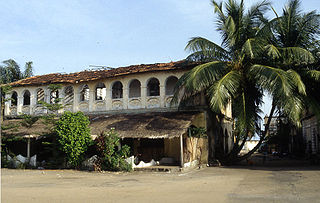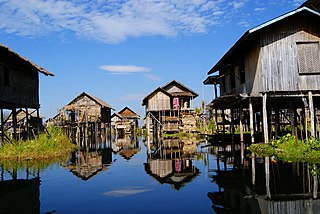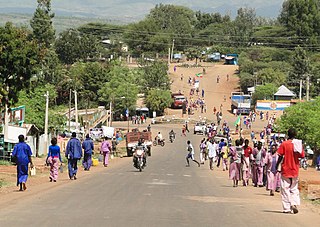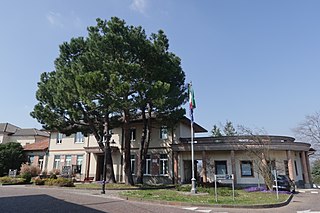
A lost city is an urban settlement that fell into terminal decline and became extensively or completely uninhabited, with the consequence that the site's former significance was no longer known to the wider world. The locations of many lost cities have been forgotten, but some have been rediscovered and studied extensively by scientists. Recently abandoned cities or cities whose location was never in question might be referred to as ruins or ghost towns. Smaller settlements may be referred to as abandoned villages. The search for such lost cities by European explorers and adventurers in Africa, the Americas, and Southeast Asia from the 15th century onwards eventually led to the development of archaeology.

Bad Schussenried is a spa town in Upper Swabia in the district of Biberach, Baden-Württemberg, Germany.

The Western Region is located in south Ghana, spreads from the Ivory Coast in the west to the Central region in the east, includes the capital and large twin city of Sekondi-Takoradi on the coast, coastal Axim, and a hilly inland area including Elubo. It includes Ghana's southernmost location, Cape Three Points, where crude oil was discovered in commercial quantities in June 2007. The region covers an area of 13,842 km2, and had a population of 2,060,585 at the 2021 Census.

Grand-Bassam is a town in southeastern Ivory Coast, lying east of Abidjan. It is a sub-prefecture of and the seat of Grand-Bassam Department; it is also a commune. During the late 19th century, Grand-Bassam was briefly the French colonial capital of Ivory Coast. Because of its outstanding examples of colonial architecture and town-planning, and the juxtaposition of the colonial town with a traditional Nzema village, the historic center of Grand-Bassam was designated a UNESCO World Heritage Site in 2012.

Attersee am Attersee is a village on the western shore of Attersee lake in the Austrian state of Upper Austria.

Manerba del Garda is a town and comune in the province of Brescia, in Lombardy. It is located at the southwest side of the Lake Garda.

Polpenazze del Garda is a comune in the province of Brescia, in Lombardy, northern Italy. It is situated near the western shore of Lake Garda.

Peschiera del Garda is a town and comune in the province of Verona, in Veneto, Italy. When Lombardy-Venetia was under Austrian rule, Peschiera was the northwest anchor of the four fortified towns constituting the Quadrilatero. The fortress is on an island in the river Mincio at its outlet from Lake Garda.
Tichit, or Tichitt, is a partly abandoned village at the foot of the Tagant Plateau in central southern Mauritania that is known for its vernacular architecture. The main agriculture in Tichit is date farming, and the village is also home to a small museum.

Stilt houses are houses raised on stilts over the surface of the soil or a body of water. Stilt houses are built primarily as a protection against flooding; they also keep out vermin. The shady space under the house can be used for work or storage. Stilt houses are commonly found in Southeast Asia, Oceania, Central America, Caribbean, northern parts of South America, Madagascar, Mauritius, Seychelles, the Maldives.

Karat is a town in south-western Ethiopia and the capital of the Konso Zone in the new South Ethiopia Regional State. Situated 20 km north of the Sagan River, this town has a latitude and longitude of 5°15′N37°29′E and an elevation of 1,650 metres (5,410 ft). It is also called Pakawle by some of the neighboring inhabitants. The town and the surrounding villages were inscribed on the UNESCO World Heritage List in 2011 as a cultural landscape for its unique cultural traditions and importance for the Konso people.

Ghana is a multilingual country in which about eighty languages are spoken. Of these, English, which was inherited from the colonial era, is the official language and lingua franca. Of the languages indigenous to Ghana, Akan is the most widely spoken in the south. Dagbani is most widely spoken in the north.

Bodio Lomnago is a comune (municipality) in the province of Varese, in the Italian region of Lombardy.

Piadena is a former comune in the Province of Cremona, Italy. On January 1, 2019 it merged with Drizzona to form Piadena Drizzona.

Akwidaa is a small town and fishing village in Ahanta West district, a district in the Western Region of south-west Ghana, and is one of the southernmost places in Ghana.

Dayan, commonly called the Old Town of Lijiang is the historical center of Lijiang City, in Yunnan, China. It is a UNESCO World Heritage Site.

Prehistoric pile dwellings around the Alps are a series of prehistoric pile dwelling settlements in and around the Alps built from about 5000 to 500 BC on the edges of lakes, rivers or wetlands. In 2011, 111 sites located variously in Switzerland (56), Italy (19), Germany (18), France (11), Austria (5) and Slovenia (2) were added to the UNESCO World Heritage Site list. In Slovenia, these were the first World Heritage Sites to be listed for their cultural value.

Prehistoric pile dwellings around Lake Zurich are pile dwelling sites located around Lake Zurich in the cantons of Schwyz, St. Gallen and Zürich.

James Van Leuven Mensah was a Ghanaian accountant, public servant, banker, and politician. He was born at Kengen, Ghana to Joseph Mensah and Yanke Adela 8 February 1937. His father was a Catchiest from Nkroful. After settling at Kengen, Joseph named his son after a Dutch missionary he worked with, Fr. Van Leuven, at the local Saint Mary's Catholic Church.























